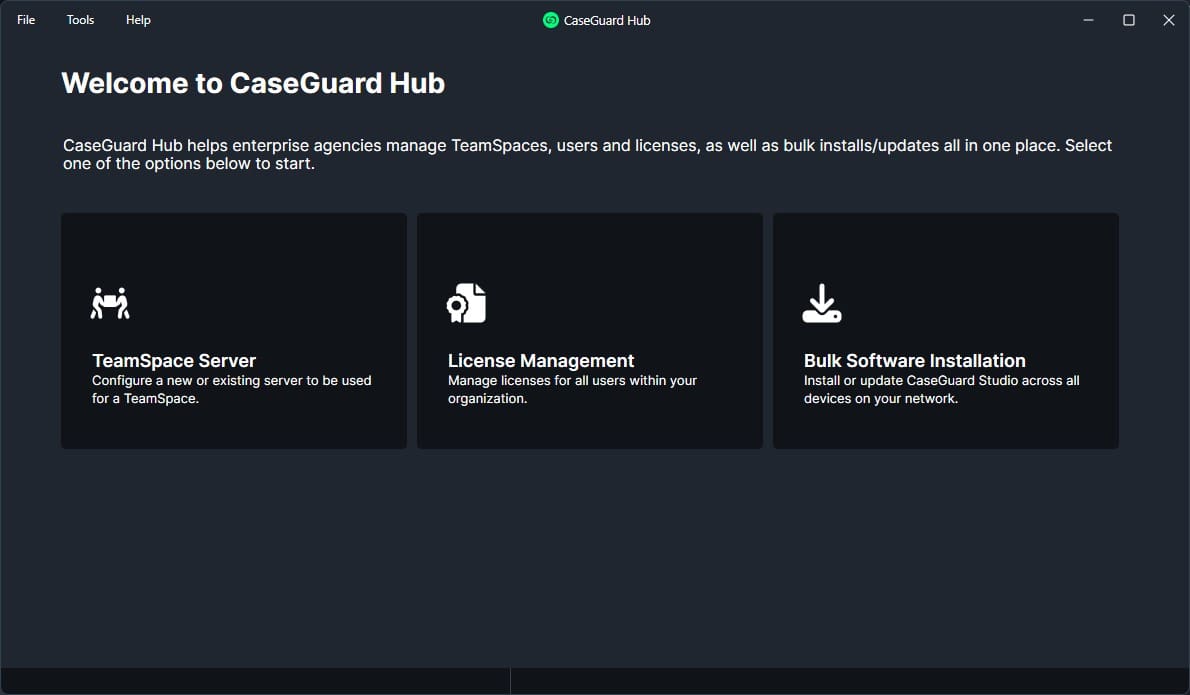What is the TeamSpace in CaseGuard?
CaseGuard’s TeamSpace is a brand-new collaboration tool that was formerly known as CaseGuard’s Redaction Pool. The new TeamSpace tool allows users to easily collaborate and manage all redaction projects in one location. This guide will demonstrate how to set up CaseGuard’s TeamSpace effortlessly.
Choosing a Host Machine
Before beginning, you need to choose which user machine will host the TeamSpace server. We strongly recommend running TeamSpace on a separate machine or server, not the same one a user will be working on. Please note that, like the previous Redaction Pool, all users who wish to connect to TeamSpace must be on the same network. Once you have selected a host machine, follow the steps below.
Setting Up Your TeamSpace Server
Step 1: Install the Required Applications
- Install the new CaseGuard Hub application on the host machine. You can find this on the CaseGuard website where you originally installed the CaseGuard application.
- If you are unsure of the website, please contact your dedicated account manager or email [email protected].
- Install Microsoft’s .NET 8.0 framework on the host machine. This framework allows the machine to host a server.
- Download .NET 8.0 here.
- Once downloaded, run the .EXE file and complete the installation process.
Step 2: Run and Configure CaseGuard Hub
- Open the CaseGuard Hub file that you installed from the CaseGuard website.
- Complete the installation and open CaseGuard Hub.
- Upon opening, you will be greeted with three options. Select TeamSpace Server.

Step 3: Create a TeamSpace Server
- The Manage Servers window will open. Click Add New Server in the top right corner.

- In the Create TeamSpace Server window, configure the following settings:
- Server Name (A name for your TeamSpace server.)
- Server Port (Choose the port for server communication.)
- Server Password (Optional: Require a password for users to connect.)
- Server Admin Password (Required for admin access.)
- Secret Key (For API authentication between Studio and Teamspace Server.)
- Storage Location (Where the TeamSpace server and its files will be stored.)
- Create a Default TeamSpace (This option will automatically generate a default TeamSpace with preconfigured settings.)

- Uncheck the Create a default TeamSpace option to create and configure your own TeamSpace.
- Click Create once all settings are configured.
- A Windows Security pop-up will appear asking to allow TeamSpace.API. Select Allow.
- Your TeamSpace server is now created!
Step 4: Managing Your TeamSpace Server
- After creation, you will be redirected to the Manage Servers window, where you can:
 View TeamSpace – See all contents inside your TeamSpace.
View TeamSpace – See all contents inside your TeamSpace. Manage Server – Edit your TeamSpace settings (Note: The server must be stopped before making changes).
Manage Server – Edit your TeamSpace settings (Note: The server must be stopped before making changes). Stop Server – Pause the server to make adjustments.
Stop Server – Pause the server to make adjustments.- Add New Server – Create additional Servers for different teams or departments.

- Click
 View TeamSpace to open your new TeamSpace server.
View TeamSpace to open your new TeamSpace server.
Step 5: Managing TeamSpaces
- Once in the TeamSpaces Management window, select Add New TeamSpace to create your first TeamSpace.

- The Create TeamSpace window will open, give your TeamSpace a name related to the projects your team will be working on inside.
- You can also add a password to TeamSpace if you’d like.

- Once configured select Create, and you will taken back to the TeamSpaces Management window.
In the TeamSpaces Management window, you can:
 View Projects – Manage all projects inside your TeamSpace.
View Projects – Manage all projects inside your TeamSpace. Edit TeamSpace – Rename your TeamSpace or add a password.
Edit TeamSpace – Rename your TeamSpace or add a password. Delete TeamSpace – Remove a TeamSpace permanently.
Delete TeamSpace – Remove a TeamSpace permanently.- Add New TeamSpace – Create additional TeamSpaces for different teams within the same server.

Your TeamSpace is now created! Users will now be able to access the TeamSpace inside of their CaseGuard.
Connecting to TeamSpace
Once your TeamSpace is created, users on the same network should be able to see the server when they open the  TeamSpace icon inside CaseGuard.
TeamSpace icon inside CaseGuard.
- If the TeamSpace does not appear automatically, users can connect manually by selecting Connect Manually and entering the IP address and Port of the server.
- Users should first log into CaseGuard Studio before logging into CaseGuard Hub. Logging into the Hub first will result in being logged out.
Need Help?
If you encounter any challenges while setting up a TeamSpace server, don’t hesitate to reach out. Our support team is here to assist and ensure your workflow remains seamless.
Simply email us at [email protected], and we’ll be happy to help.
Was this article helpful to you?
No
Yes